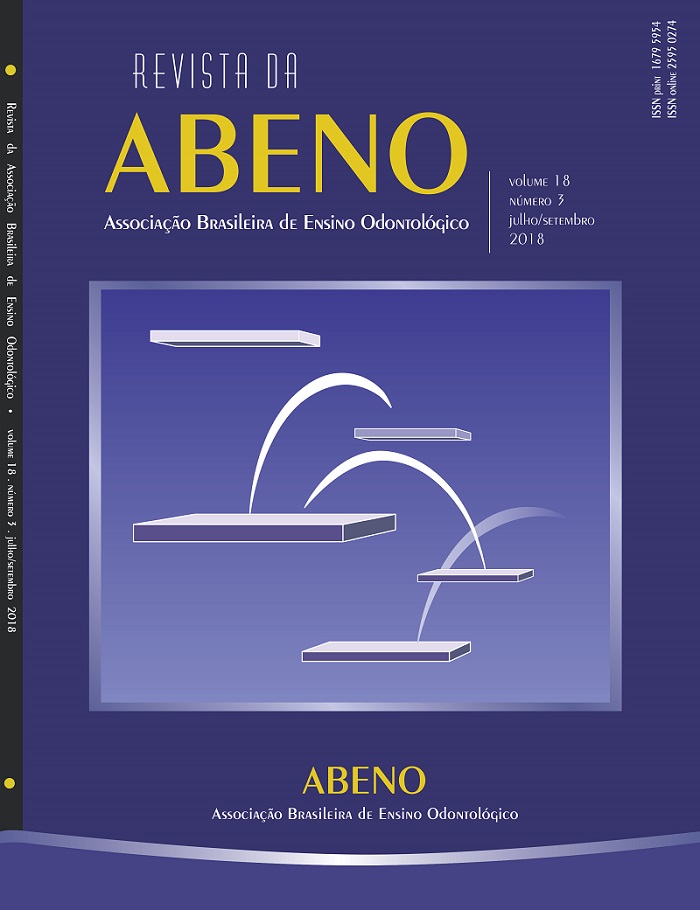Professional training and knowledge on biosafety by Oral Health Assistants of the public and private sectors
DOI:
https://doi.org/10.30979/rev.abeno.v18i3.470Keywords:
Professional Training. Dental Professionals. Exposure to Biological Agents.Abstract
In dentistry, knowledge of biosafety measures related to infection control is a constant concern, since acquired knowledge can be applied to the prevention, minimization, or elimination of health risks. The objective of this study was to verify the relationship between professional training and biosafety knowledge of Oral Health Assistants (OHAs) of the public and private sectors in a city in southwestern Bahia. This is a cross-sectional study involving 44 professionals, 16 from the public sector and 28 from the private sector. A semi-structured questionnaire with 22 questions was used. Data were analyzed using descriptive statistics and a chi-square test. Data analysis revealed that 45.5% of the OHAs had not yet completed a vocational technical training or refresher course, and 77.3% had not registered with the Regional Council of Dentistry. Participants who had received some kind of technical-scientific information showed more knowledge about the meaning of the term biosafety (p<0.05) and performed handwashing more frequently between patients (p<0.05). The public sector professionals showed greater knowledge about the meaning of the term biosafety (p<0.05) and the possibility of disease transmission to patients (p<0.05) compared to those in the private sector. It was observed in this study that better professional training of the OHAs can positively influence the knowledge of biosafety regarding the control of infection.
Downloads
References
Diniz DN, Bento PM, Pereira M, Pereira JV, Silva DF, Costa M, et al. Avaliação do conhecimento sobre biossegurança em radiologia pelos alunos do curso de Odontologia da Universidade Estadual da Paraiba. Arq Ciênc Saúde. 2009;16(4):166-9.
Krieger D, Bueno R, Gabardo MCL. Perspectivas de biossegurança em odontologia. Rev Gestão Saúde. 2010;1(2):1-10.
Frazão P, Narvai PC. Lei n. º 11.889/2008: avanço ou retrocesso nas competências do técnico em saúde bucal? Trab Educ Saúde. 2011;9(1):109-23
Duarte Filho ESD, Alves GG, Pinheiro FHdSL, de Lima Martelli PJ. Os riscos ocupacionais dos Auxiliares em Saúde Bucal. CATUSSABA-ISSN 2237-3608. 2012;1(2) :57-64.
Paranhos LR, Ricci ID, Tomasso S, Siqueira DF. Análise da relação entre o cirurgião-dentista e o pessoal auxiliar. Rev Odonto Ciência. 2008;23(4):365-70.
Mutters NT, Hägele U, Hagenfeld D, Hellwig E, Frank U. Compliance with infection control practices in an university hospital dental clinic. GMS Hyg Infec Control. 2014;9(3). DOI: 10.3205/dgkh000238
Cortelli AFD. Procedimentos de biossegurança adotados por profissionais prestadores de serviços de manicure, pedicure, tatuagem, piercing e maquiagem definitiva no município de Jacareí-SP [dissertação] São Paulo: Universidade de São Paulo; 2012.
Silva MPd, Costa GS, Crispim ZAMdP, Castro EA, Cerqueira MBR, Garibalde E. Views of oral health teams in northern Minas Gerais on the training of NHS oral health technicians. Trab Educ Saúde. 2014;12(1):69-85.
Leite DFBM, Farias IAP, Costa AdPCd, Barbosa LEdO, Muniz IdAF, Muniz IdAFM. Perfil socioeconômico dos alunos concluintes dos cursos de auxiliar e técnico em saúde bucal. Rev Odontol UNESP. 2012;41(2):95-101.
Silva RFd, Monini AdC, Valladares Neto J, Francesquini Júnior L, Daruge Júnior E. Percepção dos auxiliares odontológicos na clínica ortodôntica quanto aos seus limites de atuação profissional. Rev Dental Press Ortod Ortop Facial. 2009;14(3):34-39.
da Silva GS, de Almeida AJ, de Paula VS, Villar LM. Conhecimento e utilização de medidas de precaução-padrão por profissionais de saúde. Esc Anna Nery. 2012;16(1):103-10.
BRASIL. Conselho Federal de Odontologia. Código de Ética Odontológica, 2012. Resolução CFO-118/2012.20. (Acesso em 05 jan. 2017). Disponível em: http://www. cropr.org.br/uploads/arquivo/6e78019d4c01c2576de61febb33ff295.pdf.
Rodrigues VC. Hepatite B no Município de Ribeirão Preto (SP): um estudo envolvendo cirurgiões-dentistas e auxiliares odontológicos [dissertação]. Ribeirão Preto: Universidade de São Paulo; 2002.
Uchida TH, Terada RSS, Tenuta LMA, Fujimaki M. Práticas preventivas realizadas por Técnicos em Saúde Bucal: um estudo qualitativo. Rev ABENO. 2016;16(1):110-24.
Zanetti CHG, Mendonça MHMd, Oliveira JAAd. Divisão do trabalho odontológico em perspectiva: desafio de interpretar as competências dos técnicos. Trab Educ Saúde. 2012;10(2):195-222.
Downloads
Published
How to Cite
Issue
Section
License
Autores que publicam nesta revista concordam com os seguintes termos:
a) Autores mantém os direitos autorais e concedem à revista o direito de primeira publicação, com o trabalho simultaneamente licenciado sob a Licença Creative Commons Attribution que permite o compartilhamento do trabalho com reconhecimento da autoria e publicação inicial nesta revista.
b) Autores têm autorização para assumir contratos adicionais separadamente, para distribuição não-exclusiva da versão do trabalho publicada nesta revista (ex.: publicar em repositório institucional ou como capítulo de livro), com reconhecimento de autoria e publicação inicial nesta revista.
c) Autores têm permissão e são estimulados a publicar e distribuir seu trabalho online (ex.: em repositórios institucionais ou na sua página pessoal) a qualquer ponto antes ou durante o processo editorial, já que isso pode gerar alterações produtivas, bem como aumentar o impacto e a citação do trabalho publicado (Veja O Efeito do Acesso Livre).






